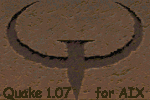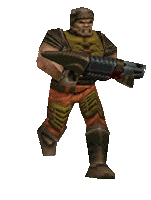
FAQ for Quake Version 1.07 on RS/6000 Systems
Question 1 What is Quake?
Question 2 Where do I get AIX Quake?
Question 3 What are the system requirements for AIX Quake?
Question 4 How do I install AIX Quake?
Question 5 How do I run Quake, what command line options are available?
Question 6 How do I maximize performance of AIX Quake?
Question 7 Can I play networked Quake (even with non-AIX)?
Question 8 Where can I learn more about Quake?
Question 9 How do I get support for Quake?
Question 10 Release Notes
Question 11 How do I manage connecting to regular quake and CTF servers...
What is Quake?
 Quake is a 3D combat adventure
game from id Software. Optimized for PowerPC-based RS/6000 workstations,
Quake for AIX delivers! Challenge yourself to a single player stroll
through this surrealistic underground maze of obstacles and monsters.
Or, close your office door, adjust the volume on your RS/6000 workstation and engage in a network enabled multiplayer Deathmatch.
Quake is a 3D combat adventure
game from id Software. Optimized for PowerPC-based RS/6000 workstations,
Quake for AIX delivers! Challenge yourself to a single player stroll
through this surrealistic underground maze of obstacles and monsters.
Or, close your office door, adjust the volume on your RS/6000 workstation and engage in a network enabled multiplayer Deathmatch.
Where do I get AIX Quake?
This is the new Quake 1.07 software version.
There are two ways to get Quake for AIX, You can download the big install. This will get the quake exes and the rather large shareware pak file. If you already have Quake installed, and want to update it, you can get just the exes. The "just the exes" and the "big install" will both have identical versions of Quake. The data file (included in "big install") never changes, so you only need to download it the first time you download quake.
What are the system requirements for AIX Quake?
To maximize gameplay, these games require:
- PowerPC-based RS/6000 workstation,
- AIX Version 4.1.5 or AIX 4.2.1
- AIX Ultimedia Services/6000 2.1.4 (or higher),
- Audio sub-system and speakers,
- Network connection (for multi-player mode),
- 25 Meg Hard Drive Space
How do I install AIX Quake?
After downloading the tar.Z file, you will need to
uncompress quake.sw.tar.Z
This will create quake.sw.tar, which you can install anywhere you want to:
tar -xvf quake.sw.tarThis will give you the following files:
- quake.sw (executable)
- quake.sw.wimp (executable that doesn't require UMS )
- go_quake (start script)
- id1/pak0.pak (data file for shareware Quake)
- libXext.a.4* (if you get unresolved externals, you can try using these libraries, by renaming the right one for your version of AIX to libXext.a. Then you should notice that the go_quake script modifies your LIBPATH to include the current directory first. As PTF's become available for these X Server modifications, they will be put into this document.
How do I run Quake, what command line options are available?
you can run quake using the provided script: go_quake
Here are some command line options, go look at www.stomped.com for full list.
You will also want to learn how to use console commands, these are outlined
on www.stomped.com as well.
| command line switch | effect |
|---|---|
| -nosound | turns off audio, can speed up some systems Definitely use this if you are running quake.sw.wimp, so that quake won't waste time generating the sounds. |
| +volume .05 | adjusts volume (can be .01 to 1.0) |
| +connect SERVERNAME | connect to quake server |
| -grabmouse | grabs your mouse to use in Quake (can be toggled from options menu) |
| -winsize 600 400 | runs quake in 600 400 window |
| -winloc 0 0 | starts quake in upper left corner of screen quake defaults to running centered on the screen. -winloc 100 100 will put the upper left hand corner of the quake window 100 pixels over and 100 pixels down from the upper left of your root window. |
| +map e1m2 | loads second map (m2) in shareware level (e1) |
| -game rpbot or ctf | starts reaperbot or ctf (requires reaperbot or capture the flag levels.. see www.stomped.com) |
| -listen 16 | listening quake server for 16 clients Means that a client can play on the server machine, but he will have an unfair advantage ( 0 ping time!) |
| -dedicated 16 | dedicated quake server for 16 clients |
| -2 | Pixel replicates for faster play, but less precise rendering. Very useful on 1280x1024 displays. Only works if DISPLAY=:0.0 |
| -4 | Pixel replicates with twice the fun. Not too useful, try using -2. Not recommended. |
| -fullscreen | -fullscreen -winsize 320 240 -2 runs fullscreen on the following adapters: GXT250P, GXT255P, GXT500P, GXT550P and GXT800P. You need the following APAR loaded to have the adapters support fullscreen mode. AIX 4.1: IX69588 AIX 4.2: IX69589 |
How do I maximize performance of AIX Quake?
Make sure you are running with MIT-SHM X Server Extension. You can check by running:
xdpyinfo | pg
This will list your current list of Server extensions. It should be running by default, if not then you aren't running the GOLD level of 4.1.5 or 4.2.1. MIT-SHM will speed up the blits to the screen, and also allows you to do pixel doubling.
Pixel doubling can help performance at the cost of a little visual Quality. It's in the go_quake script by default, and people seem to like it a lot. a 320x200 window on a 1280x1024 screen really is itty bitty.
Frustrating performance of Quake on AIX 4.1.3 is due to massive differences in the way AIX timing routine seems to work. That's why Quake isn't supported on 4.1.3.
Can I play networked Quake?
Of course! You can fire up your own quake server:
go_quake -listen 16
If you are running Win95, you can connect with the Quake you
buy at the store (or downlaod) by running the Q95 bat file. If you
are running Windows NT, you will need GLQuake (and a rip romping
OpenGL accelerator), or you can run WinQuake. All of these can be
found on the Learn more about Quake on these websites:
There are a bunch of different Quake sites, these will get you started.
Earlier releases of AIX seem to have different behavior
in the timing routines I use, and also don't
have the same Shared Memory extensions. If you do
not have MIT-SHM in your list of extensions
(run xdpyinfo for list), then Quake will painfully
revert to slower methods of displaying rendered
images. Your frag count will increase if you have
MIT-SHM. ;-)
If you use the right Ctrl key on your keyboard, you
will need to remap your keys from the AIX command line:
If your config uses the meta keys (Ctrl, Alt, Shift)
for a lot of things, you might encounter problems
when a meta key and another key are held down together.
You should consider changing your key bindings.
If you are connecting to both regular quake servers, and CTF servers, and
are tired of doing the -game ctf flag on the command line, you can try this:
More info on networked quake at the Servers Page
Where can I learn more about Quake?
How do I get support for Quake?
Release Notes
xmodmap -e "keysym Execute = Control_R"
I think it defaults to some IBM mainframe key, the left
one works just fine. Note that remapping affects all your
applications. If you are logged into some mainframe, you
might care (or not care after you play Quake for a while!).
Managing connections to regular and CTF servers
standard setup of files:
id1/pak0.pak
id1/pak1.pak
ctf/pak0.pak
ctf/pak1.pak
modified setup of files:
id1/pak0.pak
id1/pak1.pak
id1/pak2.pak
id1/pak3.pak